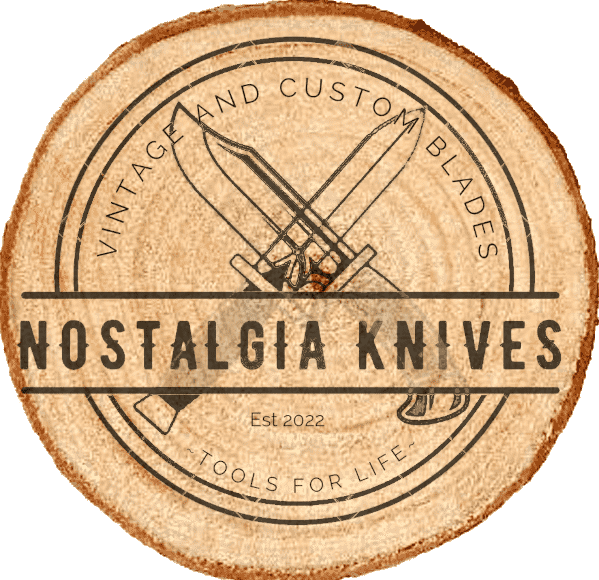Fight’n Rooster Knives
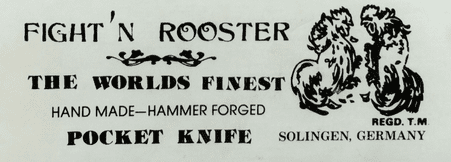
In the world of traditional pocket knives, Fight’n Rooster stands as a symbol of craftsmanship, precision, and a commitment to preserving the artistry of cutlery. Founded in the mid-20th century in Solingen, Germany, Fight’n Rooster Knives has left an enduring mark on the cutlery industry. This article explores the fascinating history and notable accomplishments of Fight’n Rooster, delving into its origins, signature designs, and the impact it has had on the world of collectible knives.
Origins in Solingen, Germany
Fight’n Rooster Knives traces its roots to the cutlery capital of the world, Solingen, Germany. The company was established in the early 1960s by Frank Buster, a visionary cutler with a passion for creating knives that were not only functional but also works of art. Frank Buster’s dedication to traditional craftsmanship and his pursuit of excellence set the foundation for what would become one of the most revered names in the cutlery industry.
Traditional Craftsmanship and Attention to Detail
Fight’n Rooster Knives quickly gained recognition for its unwavering commitment to traditional craftsmanship. The knives produced by the company were meticulously crafted using time-honored techniques, with an emphasis on precision and attention to detail. From the selection of premium materials to the intricate embellishments and hand-finished touches, Fight’n Rooster knives exemplified the epitome of traditional German cutlery craftsmanship.
Signature Designs and Iconic Handles
One of the hallmarks of Fight’n Rooster Knives was its distinctive and often ornate handle designs. The company was known for utilizing a variety of high-quality handle materials, including exotic woods, genuine stag, and mother-of-pearl. The handles were not merely functional components but served as canvases for intricate engravings, colorful inlays, and unique embellishments that set Fight’n Rooster knives apart in terms of aesthetics.
The Fight’n Rooster Logo
The company’s logo, featuring a proud rooster ready for battle, became an iconic symbol associated with quality and craftsmanship. The rooster emblem was often incorporated into the knives, whether as an etching on the blade or as an intricately designed shield on the handle. The logo became a symbol of Fight’n Rooster’s commitment to producing knives that were not only tools but also emblems of pride for collectors.
Collector Appeal and Limited Editions
Fight’n Rooster Knives garnered a dedicated following among collectors, thanks to the limited production runs and exclusive releases. The company’s approach to creating limited editions with unique handle materials, special engravings, and serialized numbering appealed to collectors seeking knives with both historical significance and aesthetic allure. The limited availability of these knives contributed to their desirability, turning Fight’n Rooster knives into sought-after treasures.
Frank Buster’s Influence and Legacy
Frank Buster, the founder of Fight’n Rooster Knives, played a pivotal role in shaping the brand’s identity and legacy. His commitment to traditional craftsmanship, coupled with an eye for innovation, laid the groundwork for the success of the company. Buster’s influence extended beyond the knives themselves; he became a respected figure in the cutlery community, leaving an indelible mark on the industry.
Transition and Closing Chapter
As with many venerable names in the cutlery world, Fight’n Rooster Knives faced challenges in the later years of its existence. The company experienced changes in ownership and production locations, and the knives produced during this period often lacked the same level of craftsmanship and attention to detail that defined the earlier Fight’n Rooster pieces.
Unfortunately, like many traditional knife companies, Fight’n Rooster eventually closed its doors. However, the knives produced during its heyday continue to be highly sought after by collectors, with each piece representing a chapter in the rich history of the brand.
Legacy and Impact on the Collectible Knife Market
Fight’n Rooster Knives left an enduring legacy that continues to resonate in the world of collectible knives. The knives produced during the company’s prime are cherished not only for their functionality but also as artistic expressions of a bygone era. The ornate handles, meticulous craftsmanship, and limited-edition releases have cemented Fight’n Rooster’s place in the hearts of collectors who appreciate the heritage and beauty of traditional pocket knives.
Fight’n Rooster Knives, born out of the cutlery-rich tradition of Solingen, Germany, stands as a testament to the enduring allure of traditional craftsmanship and attention to detail. From its origins in the early 1960s to the legacy left by founder Frank Buster, Fight’n Rooster has contributed significantly to the world of collectible knives. The brand’s knives, with their distinctive designs and ornate handles, continue to captivate enthusiasts and collectors, carrying forward the tradition of excellence that defines Fight’n Rooster’s place in the history of cutlery.
Columbia River Knife & Tool

In the world of knives, Columbia River Knife & Tool, commonly known as CRKT, has established itself as a prominent player with a reputation for innovation, quality, and cutting-edge design. Founded in the Pacific Northwest in the late 20th century, CRKT has become synonymous with a diverse range of knives that cater to the needs of outdoor enthusiasts, tactical users, and everyday carriers. Let’s delve into the captivating history of Columbia River Knife & Tool, tracing its origins, notable collaborations, and the enduring legacy it has carved in the cutlery industry.
Founding Years and Vision
Columbia River Knife & Tool was founded in 1994 by Rod Bremer in Tualatin, Oregon. Bremer, an industry enthusiast and entrepreneur, set out with a vision to create knives that would combine functionality, innovation, and affordability. From its inception, CRKT aimed to distinguish itself by collaborating with renowned knife designers, employing unconventional designs, and embracing emerging technologies in knife manufacturing.
Collaborations with Renowned Designers
One of the key factors that set CRKT apart from other knife manufacturers was its commitment to collaborating with some of the most renowned knife designers in the world. This strategy allowed CRKT to bring a diverse range of designs to market, each reflecting the unique style and expertise of the collaborating designer.
In the early years, CRKT forged partnerships with luminaries such as Ken Onion, a celebrated knife designer known for his innovative blade shapes and mechanisms. The success of the Ken Onion-designed “K.I.S.S.” (Keep It Super Simple) knife marked the beginning of CRKT’s reputation for delivering knives that were not only functional but also pushed the boundaries of design.
Innovations in Locking Mechanisms
CRKT has been at the forefront of introducing new and innovative locking mechanisms to the knife world. The company has a history of incorporating unique locking systems that enhance the safety and usability of its knives. For example, the “AutoLAWKS” mechanism, developed by acclaimed knife designer Ron Lake, automatically engages a safety lock when the blade is opened, providing an extra layer of security.
The “OutBurst” assisted opening mechanism, featured in many CRKT knives, ensures smooth and rapid deployment of the blade with the assistance of a spring. These innovations not only showcase CRKT’s commitment to functionality but also highlight its willingness to explore new technologies to enhance the user experience.
Tactical Knives and Military Collaborations
Recognizing the demand for reliable and durable knives in tactical and military applications, CRKT ventured into the realm of tactical knives. The company collaborated with military and law enforcement professionals to create purpose-built knives designed to meet the rigorous demands of those in the line of duty.
One notable collaboration was with Colonel Rex Applegate, a renowned expert in close-quarters combat and military training. The result of this partnership was the CRKT Applegate-Fairbairn Combat Knife, a design rooted in the combat experiences of its creators. This collaboration solidified CRKT’s presence in the tactical knife market, earning the company respect among military and law enforcement professionals.
Adventurous Designs for the Outdoors
CRKT has a strong presence in the outdoor and adventure knife market, offering a diverse array of knives tailored to the needs of outdoor enthusiasts, campers, and survivalists. Collaborations with designers such as Tom Krein and Jesper Voxnaes have resulted in knives that blend functionality with a distinct aesthetic appeal.
The “M16” series, a collaboration with Kit Carson, is a prime example of CRKT’s commitment to producing versatile outdoor knives. These knives feature a combination of tactical design elements and practical features, making them popular among both military personnel and outdoor enthusiasts.
Limited Editions and Collector’s Items
In addition to its regular product lineup, CRKT has periodically released limited edition knives and collector’s items. These special releases often showcase unique materials, exclusive designs, or collaborations with renowned custom knife makers. The limited availability of these knives has contributed to their collectibility, with enthusiasts eagerly seeking them to add to their collections.
Global Partnerships and Production
While CRKT is deeply rooted in the Pacific Northwest, the company has embraced a global perspective by establishing partnerships with manufacturers worldwide. By working with skilled manufacturers in different regions, CRKT has been able to leverage diverse expertise and ensure a wide range of designs and materials.
The company’s commitment to quality control and stringent standards has allowed it to maintain consistency in the production of its knives, regardless of the manufacturing location. This global approach has not only expanded CRKT’s reach but has also enabled the company to offer a diverse range of knives catering to various preferences and needs.
Continuous Innovation and Awards
CRKT’s commitment to innovation and excellence has earned the company numerous awards and accolades within the cutlery industry. The consistent pursuit of new ideas and designs, coupled with the willingness to collaborate with top-tier designers, has kept CRKT at the forefront of knife innovation.
The company has received recognition for specific knife models, innovative features, and overall contributions to the industry. These awards underscore CRKT’s dedication to pushing the boundaries of what a knife can be and its impact on shaping the future of cutlery design.
Columbia River Knife & Tool has woven a rich tapestry of innovation, collaboration, and design excellence since its founding in 1994. From the early collaborations with industry legends to the introduction of groundbreaking locking mechanisms and the exploration of the tactical and outdoor markets, CRKT has continually evolved to meet the diverse needs of knife users.
The enduring legacy of CRKT lies not only in its vast product catalog but also in its commitment to craftsmanship and innovation. As the company continues to forge new paths in the cutlery industry, one can only anticipate what exciting designs and collaborations CRKT will bring to knife enthusiasts in the years to come. Whether you’re a seasoned collector, a tactical professional, or an outdoor enthusiast, CRKT’s diverse lineup of knives has something to offer for every individual who appreciates the art and utility of a well-crafted blade.
Colonel Coon Knives

In the realm of American pocket knives, the name Colonel Coon is synonymous with quality, craftsmanship, and tradition. For decades, Colonel Coon knives have been prized by collectors and enthusiasts for their exceptional design and attention to detail. Let’s delve into the fascinating history of Colonel Coon knives, tracing their origins, rise to prominence, and enduring legacy in the world of cutlery.
Origins and Founding
The Colonel Coon knife legacy began in the early 1970s when a visionary named Adrian A. Harris founded the company in Tullahoma, Tennessee. Harris, a passionate knife enthusiast with a keen eye for craftsmanship, aimed to create knives that not only served practical purposes but also stood as works of art. The Colonel Coon brand was born out of this vision, with a commitment to producing high-quality, handcrafted pocket knives that would capture the essence of traditional American cutlery.
Handcrafted Excellence
What set Colonel Coon knives apart from the outset was their dedication to handcrafted excellence. Unlike many contemporary manufacturers who were turning to mass production and automation, Colonel Coon embraced the old-world approach of skilled craftsmen meticulously shaping, assembling, and finishing each knife by hand. This commitment to craftsmanship resulted in knives that not only served as reliable tools but also carried an inherent beauty that spoke to the heritage of American knife-making.
Colonel Coon’s Signature Patterns
One of the defining characteristics of Colonel Coon knives is the array of classic patterns that became synonymous with the brand. The company produced a variety of pocket knife styles, including trappers, stockmen, muskrats, and congress patterns, each meticulously designed and crafted. The knives featured premium materials, such as high-carbon steel blades and genuine bone handles, contributing to their durability and timeless aesthetic.
The Elusive Damascus Blades
Colonel Coon knives further solidified their reputation by offering a line of knives with Damascus steel blades. Damascus steel, known for its distinctive wavy patterns and exceptional sharpness, was a hallmark of craftsmanship and quality. Colonel Coon’s use of Damascus steel elevated their knives to a new level, appealing to collectors and enthusiasts who sought both functionality and artistry in their blades.
Limited Production and Collectibility
As Colonel Coon knives gained popularity, the company adopted a unique business strategy that contributed to the knives’ mystique. They deliberately kept production limited, creating an aura of exclusivity around their blades. This decision not only enhanced the collectibility of Colonel Coon knives but also ensured that each knife retained its value and uniqueness.
Transition and Passing of the Torch
In the early 1990s, Colonel Coon underwent a significant transition. Adrian Harris, the visionary founder, passed away, leaving a void in the leadership of the company. However, the legacy of Colonel Coon knives persisted as the business changed hands and continued to produce knives in the spirit of its founder’s vision.
Queen Cutlery Collaboration
In the later years of its existence, Colonel Coon entered into a collaboration with another respected name in American cutlery – Queen Cutlery. This partnership brought together two brands known for their commitment to quality and craftsmanship. Under the collaboration, Queen Cutlery manufactured Colonel Coon knives, ensuring that the tradition of handcrafted excellence persisted.
End of an Era
Despite the enduring popularity of Colonel Coon knives, the brand faced challenges as the 21st century progressed. The changing landscape of the cutlery industry, economic factors, and shifting consumer preferences led to the eventual closure of Colonel Coon in the mid-2000s. The closure marked the end of an era for a brand that had become synonymous with American craftsmanship and traditional pocket knives.
Legacy in the Hands of Collectors
Today, Colonel Coon knives live on in the hands of collectors and enthusiasts who recognize the timeless craftsmanship and historical significance of these blades. The knives, with their classic patterns, handcrafted details, and limited production runs, have become cherished artifacts that harken back to a golden age of American pocket knife craftsmanship.
The history of Colonel Coon knives is a tale of passion, craftsmanship, and enduring legacy. From its founding in the 1970s to its collaboration with Queen Cutlery and eventual closure, Colonel Coon knives left an indelible mark on the world of traditional American pocket knives. The commitment to handcrafted excellence, classic patterns, and limited production runs ensured that Colonel Coon knives would stand the test of time, continuing to captivate collectors and enthusiasts who appreciate the artistry and functionality of these timeless blades.
Cattaraugus Cutlery Company
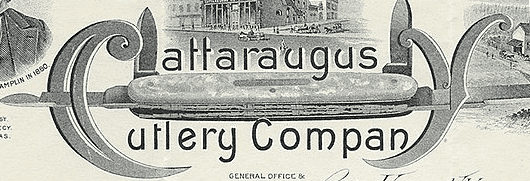
In the realm of American cutlery, the name Cattaraugus has resonated with craftsmanship and tradition for over a century. The Cattaraugus Cutlery Company, founded in the late 19th century, stands as a testament to the enduring legacy of American knife-making. From its humble beginnings to its pivotal role in equipping soldiers during wartime, the company has etched its mark on the bladesmithing landscape. Let’s embark on a journey through time, exploring the rich history of the Cattaraugus Cutlery Company.
Founding Years
The story of the Cattaraugus Cutlery Company begins in 1882, when the Cattaraugus Cutlery Company was established in Little Valley, New York. The founders, J.B.F. Champlin and his son Tint, set out with a vision to create high-quality knives that would meet the demands of both everyday users and professionals alike. Little did they know, their venture would evolve into one of the most respected names in the cutlery industry.
Early Success and Expansion
In its early years, Cattaraugus gained a reputation for producing top-notch knives, thanks to its commitment to quality materials and craftsmanship. The company quickly expanded its product line, offering a diverse range of knives suitable for various purposes, from hunting and fishing to everyday carry. The success of Cattaraugus knives was bolstered by the company’s dedication to innovation, as they continually refined their manufacturing processes and embraced new technologies.
Military Contracts and World War Efforts
As the world found itself thrust into the turmoil of World War I, Cattaraugus played a crucial role in supporting the Allied forces. The U.S. military recognized the company’s ability to produce reliable and durable knives, leading to significant contracts for military-issue blades. Cattaraugus knives became standard issue for American soldiers, earning the company a lasting place in the history of wartime cutlery.
The Great Depression and Adaptation
The Great Depression posed a formidable challenge to businesses across the nation, and Cattaraugus was not exempt from the economic hardships of the era. To survive, the company adapted its production to cater to a changing market. While continuing to produce high-quality knives, Cattaraugus also diversified its offerings to include kitchen cutlery and other utility tools, ensuring its relevance in households across America.
World War II and Continued Service
With the outbreak of World War II, Cattaraugus once again answered the call of duty. The company secured contracts to supply knives for the U.S. military, reaffirming its status as a trusted provider of combat-ready blades. Cattaraugus knives became an essential tool for soldiers in various theaters of war, and the company’s commitment to excellence remained unwavering.
Post-War Era and Transition
After the conclusion of World War II, Cattaraugus faced the challenges of transitioning back to a peacetime economy. The company continued to adapt to the changing demands of consumers, expanding its product range to include pocket knives, folding knives, and specialized blades for outdoor enthusiasts. Despite the changing landscape of the cutlery industry, Cattaraugus maintained its dedication to quality and craftsmanship.
Decline and Closure
However, as the latter half of the 20th century unfolded, the American cutlery landscape underwent significant changes. Increased competition, shifts in consumer preferences, and economic challenges led to the decline of many longstanding knife manufacturers. Unfortunately, the Cattaraugus Cutlery Company was not immune to these pressures, and in 1963, the company closed its doors for the last time.
Legacy and Collectibility
Despite its closure, the legacy of the Cattaraugus Cutlery Company lives on. Cattaraugus knives, cherished for their craftsmanship and historical significance, have become highly sought-after collectibles. Knife enthusiasts and collectors avidly seek out vintage Cattaraugus blades, appreciating the attention to detail and quality that defined the company’s products.
The history of the Cattaraugus Cutlery Company is a tapestry woven with innovation, dedication, and resilience. From its early days in Little Valley to its pivotal role in equipping soldiers during times of war, Cattaraugus left an indelible mark on the American cutlery landscape. While the company may no longer produce knives, its legacy endures through the hands of collectors and the blades that bear the Cattaraugus name, a timeless reminder of a bygone era of American craftsmanship.
A Guide to Replacing Fixed Blade Knife Scales On Your Favorite Vintage Blade.
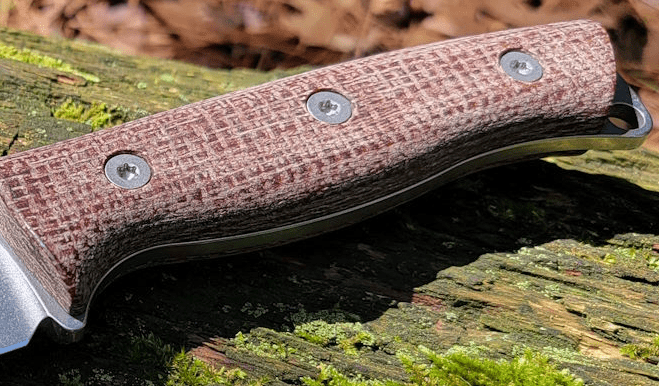
A well-crafted fixed blade knife is more than a tool; it’s a testament to craftsmanship and history. If you find yourself with an old knife that has seen better days, rejuvenating it by replacing the worn-out scales can breathe new life into both its aesthetic appeal and functionality. In this guide, we’ll take you through the step-by-step process of replacing fixed blade knife scales, ensuring your vintage blade becomes a functional work of art once again.
Materials Needed:
Old fixed blade knife
Replacement knife scales
Screwdriver
Epoxy adhesive
Clamps
Sandpaper (various grits)
Linseed oil or another finish of choice
Disposable gloves
Rags
|Advertisement Links|
Acrylic Scales – Knife Handle Slab Material
Ironwood Burl Pattern Knife Scale Slapsz
G10 Micarta Red & Black Custom Handle Scale Slabs”
Bob Smith Industries BSI-201 Quik-Cure Epoxy (4.5 oz. Combined),Clear
Step 1: Gather Your Materials
Before you start, make sure you have all the necessary materials at hand. Ensure that your replacement knife scales match the size and shape of the original scales for a seamless fit.
Step 2: Remove the Old Scales
Using a screwdriver, carefully remove any screws or fasteners securing the old scales to the knife. Take note of their arrangement as you’ll need this information when attaching the new scales. Gently pry off the old scales, being cautious not to damage the blade or tang in the process.
Step 3: Clean the Tang and Blade
Once the old scales are removed, clean the tang and blade thoroughly. Remove any residual adhesive or debris to create a clean surface for attaching the new scales.
Step 4: Prepare the Replacement Scales
If your replacement scales are not pre-shaped to match the original ones, use the old scales as templates. Trace their outline onto the new scales and cut them to size using a saw or a rotary tool. Sand the edges to achieve a smooth and comfortable fit.
Step 5: Test Fit the New Scales
Before applying any adhesive, conduct a test fit of the new scales on the knife. Ensure that they align perfectly with the tang and that any holes for screws match up. If adjustments are needed, trim or sand the replacement scales accordingly.
Step 6: Apply Epoxy Adhesive
Once you’re satisfied with the fit, it’s time to attach the new scales. Apply a thin, even layer of epoxy adhesive to the tang of the knife. Make sure to spread the adhesive evenly to avoid uneven pressure points when clamping.
Step 7: Attach the New Scales
Carefully position the replacement scales onto the tang, ensuring that they align precisely with the blade. Press them firmly into place. If using screws, reinsert them through the holes in the scales and screw them into the corresponding holes in the tang.
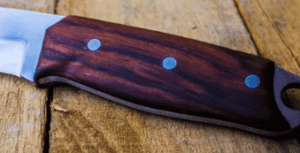
Step 8: Clamp and Allow to Cure
To ensure a secure bond, use clamps to hold the scales firmly against the tang. Wipe away any excess epoxy that may have squeezed out during this process. Allow the adhesive to cure according to the manufacturer’s instructions.
Step 9: Shape and Sand the Scales
Once the adhesive has fully cured, remove the clamps and begin shaping the scales to your desired profile. Use sandpaper with progressively finer grits to smooth the edges and achieve a comfortable grip.
Step 10: Apply Finish
To protect and enhance the appearance of the new scales, apply a finish of your choice. Linseed oil is a popular option for a natural, matte finish. Allow the finish to dry thoroughly before handling the knife.
|Advertisement Links|
Flitz Multi-Purpose Polish and Cleaner Liquid All Metal DOES NOT HARM Plastic & Fiberglass
Beeswax Polish for Leather & Wood – Natural Finishing Wax
Bringing Your Vintage Blade Back to Life
With the replacement of fixed blade knife scales complete, your vintage blade has undergone a transformation. Not only does it regain its functionality, but it also becomes a tangible link to the craftsmanship and history encapsulated in a well-worn tool. Take pride in the restoration of your vintage knife, and let its renewed vitality inspire your future adventures.
Remember, every knife has a story, and by preserving and enhancing its features, you become part of that narrative. Happy crafting, and may your vintage blades continue to serve you well!
